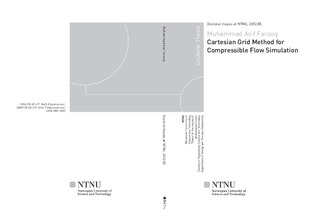| dc.contributor.author | Farooq, Muhammad Asif | nb_NO |
| dc.date.accessioned | 2014-12-19T11:48:19Z | |
| dc.date.available | 2014-12-19T11:48:19Z | |
| dc.date.created | 2012-05-25 | nb_NO |
| dc.date.issued | 2012 | nb_NO |
| dc.identifier | 528441 | nb_NO |
| dc.identifier.isbn | 978-82-471-3445-0 (printed ver.) | nb_NO |
| dc.identifier.isbn | 978-82-471-3446-7 (elctronic ver.) | nb_NO |
| dc.identifier.uri | http://hdl.handle.net/11250/234610 | |
| dc.description.abstract | The Cartesian grid method is an alternative to the existing methods to solve a physical problem governed by partial differential equations (PDEs) computationally. Researchers are interested in this method due to its simplicity of grid generation, less computational effort and ease of implementation into a computer code. One of the other options to solve a physical PDE problem is by the body-fitted grid method. In the body-fitted grid method, the boundary points are grid points. This is not the case with the Cartesian grid method where the body wall is embedded as a boundary into a Cartesian grid resultingin irregular cells near the embedded boundary. These irregular cells near the embedded boundary are known as cut-cells. Instead of using special treatmentsof the cut-cells or enforcing the presence of the embedded boundary by adding source terms at the Cartesian grid points near the boundary, the kinematic and other boundary conditions can be introduced in the Cartesian grid method via ghost points. Those grid points which lie inside the embedded boundary and are also a part of computation are called ghost points. Inactive grid points inside the embedded boundary are referred to as solid points. In the present Cartesian grid method, based on a ghost point treatment, local symmetry conditions are imposed at the embedded wall boundary. The ghost point treatments available in the literature are difficult to implement due to complex procedures. We are introducing a new approach to approximate the kinematics of the embedded boundary by a very simple ghost point treatment called the simplified ghost point treatment. In this approach, we consider the grid lines in the x- and y- directions as approximations of the lines normal to the embedded boundary depending on whether the angle between the normal and the x- or y-directions is closer. For 1D hyperbolic nonlinear systems of conservation laws, we use the moving normal shock wave as a test case for the 1D compressible Euler equations.For the 2D compressible Euler equations, we test the simplified ghost point treatment for an oblique shock wave generated by a wedge. Then, we verified our approach for slender bodies, namely for supersonic flow over a circular arc airfoil and for transonic flow over a circular arc bump in a channel. In a final problem, we applied the simplified ghost point treatment to blunt body flow and considered supersonic flows over a cylinder using the 2D compressible Euler and Navier-Stokes equations. The results are good or comparable to those found in the existing literature. | nb_NO |
| dc.language | eng | nb_NO |
| dc.publisher | NTNU | nb_NO |
| dc.relation.ispartofseries | Doctoral Theses at NTNU, 1503-8181; 2012:85 | nb_NO |
| dc.relation.haspart | Farooq, M. Asif; Müller, B.. Analysis of the Accuracy of the Cartesian Grid Method. Proceedings of the 23rd Nordic Seminar on Computational Mechanics: 53-56, 2010. | nb_NO |
| dc.relation.haspart | Farooq, M. Asif; Müller., B.. Investigation of the Accuracy of the Cartesian Grid Method.. Proceedings of the 8th International Bhurban Conference on Applied Sciences & Technology: 45-53, 2011. | nb_NO |
| dc.relation.haspart | Farooq, Muhammad Asif; Muller, Bernhard. A cartesian Grid Method for Compressible Inviscid Flows. Proceedings of the 6th National Conference on Computational Mechanics: 47-57, 2011. | nb_NO |
| dc.relation.haspart | Farooq, M. Asif; Müller., B.. Cartesian Grid Method for the Compressible Euler Equations.. Finite Volumes for Complex Applications VI Problems & Perspectives: 449-456, 2011. 10.1007/978-3-642-20671-9_47. | nb_NO |
| dc.relation.haspart | Farooq, Muhammad Asif; Muller, Bernhard. Accuracy Assessment of the Cartesian grid method for compressible inviscid flows using a simplified ghost point treatment. Rakenteiden Mekaniikka. (ISSN 0783-6104). 44(3): 279-291, 2011. | nb_NO |
| dc.relation.haspart | Farooq, M. Asif; Müller, B.. A Cartesian Grid Method for Compressible Flows to Compute Shock Waves.. Proceedings of the 9th International Bhurban Conference on Applied Sciences & Technology: 274-282, 2012. 10.1109/IBCAST.2012.6177565. | nb_NO |
| dc.title | Cartesian Grid Method for Compressible Flow Simulation | nb_NO |
| dc.type | Doctoral thesis | nb_NO |
| dc.source.pagenumber | 144 | nb_NO |
| dc.contributor.department | Norges teknisk-naturvitenskapelige universitet, Fakultet for ingeniørvitenskap og teknologi, Institutt for energi- og prosessteknikk | nb_NO |
| dc.description.degree | PhD i energi- og prosessteknikk | nb_NO |
| dc.description.degree | PhD in Energy and Process Engineering | en_GB |

